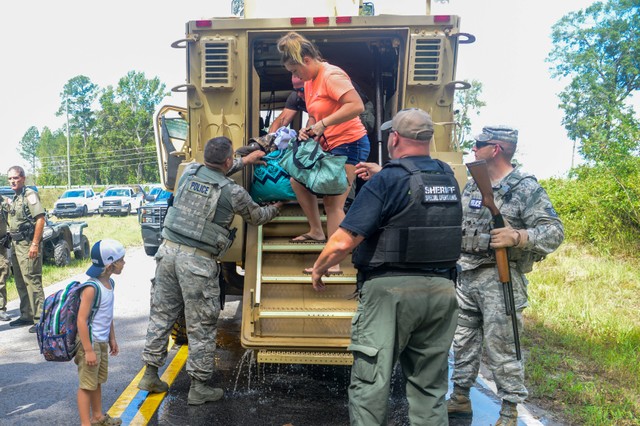WILMINGTON, N.C. (Reuters) – Rivers and waterways, swollen after Florence’s historic deluge, rose dangerously across the Carolinas on Tuesday, closing roads, inundating communities, hindering rescue and repair efforts and preventing evacuees from returning home.
Though slow-moving Florence has moved into the U.S. northeast, allowing glimpses of sunlight in the waterlogged state, at least 16 rivers remained at a major flood stage with three others set to crest in the coming days, the state said.
“One thing we know is that sunshine doesn’t necessarily mean safety,” North Carolina Governor Roy Cooper told a late-afternoon press conference and warned the 15,000 residents living in shelters against returning home too soon.
More than 1,100 roads were still closed across North Carolina, Cooper said, including several portions of Interstates 40 and 95.
Florence, which made landfall on Friday as a Category 1 hurricane before it was downgraded, has already killed at least 33 people, including 26 in North Carolina and six in South Carolina.
One person was killed in Virginia when the storm spawned some 16 tornadoes there on Monday, according to the National Weather Service.
The White House said President Donald Trump would visit North Carolina on Wednesday. He was criticized for his handling of Hurricane Maria, which devastated Puerto Rico last year, and more recently for disputing the official death toll of 3,000.
‘DRIVING NOT ADVISED’
In the town of Fair Bluff, North Carolina, which has struggled to recover from the devastation of Hurricane Matthew in 2016, only about 50 residents remained on Tuesday, Fair Bluff Police Chief Chris Chafin told Reuters.
The town has largely been cut off by flooding from the still-rising Lumber River, which was expected to crest on Wednesday.
“I haven’t been home since it started. I can’t get home either,” Chafin said.
Much of Columbus County, where Fair Bluff is located, was under water, according to Steve Abbott of the North Carolina Department of Transportation, with most roads closed and “driving not advised.”
The Cape Fear River was also expected to keep rising in Fayetteville, a city of 200,000 in the southern part of the state near the Fort Bragg army base, according to the National Weather Service. That has hampered efforts to restore power, clear roads and allow residents to homes.
Florence dumped more than 8 trillion gallons (30 trillion litres) of rain on North Carolina, the weather service said.
“Road conditions are starting to improve in some parts of our state but rising creeks, streams and rivers continue to make travel unsafe,” Cooper said.
Brock Long, head of the Federal Emergency Management Agency, appeared with Cooper and said his agency would help restore power and open roads.
“I think the next 48 hours are going to be incredibly critical,” he said.
THOUSANDS OF RESCUES
In South Carolina, 40 major roads were closed.
Fire and rescue crews were waiting to go into many areas to assist with structural damage after Florence dumped up to 36 inches (91 cm) of rain on the state since Thursday.
Thousands of rescues have taken place in the Carolinas, and more than 650 people were taken to safety in and around Wilmington, North Carolina, said Barbi Baker, a spokeswoman for New Hanover County.
The coastal city took a direct hit when Hurricane Florence came ashore and has been largely cut off since then due to storm surges and flooding from the Cape Fear River.
More than 324,000 customers, mostly in the Carolinas, were without power on Tuesday, according to power companies, down from a peak of nearly 1 million outages.
North Carolina estimated on Tuesday 3.4 million poultry birds and 5,500 hogs died in the storm, exceeding the number killed in the state’s last major hurricane two years ago.
Property damage from the storm is expected to range from $17 billion to $22 billion, the risk management firm Moody’s Analytics said. Further flooding could push up that figure.


